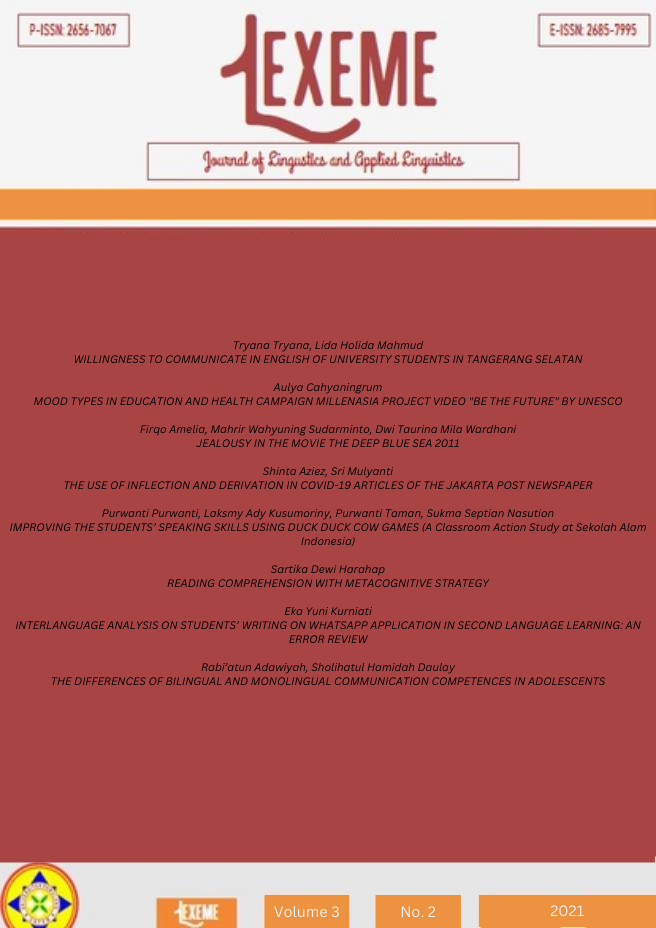IMPROVING THE STUDENTS’ SPEAKING SKILLS USING DUCK DUCK COW GAMES (A Classroom Action Study at Sekolah Alam Indonesia)
DOI:
https://doi.org/10.32493/ljlal.v3i2.18621Keywords:
Duck duck cow, Games, Teaching speakingAbstract
The purpose of this study is to find out whether teaching speaking using duck-cow games can improve students' speaking skills or not. The teachers who teach speaking skills have to choose creative and fun activities to learn with students. Games can be used to practice all skills (reading, writing, listening, and speaking), all phases of the teaching/learning sequence (presentation, repetition, recombination, and free speech), and many types of communication (e.g., encouraging, criticizing, agreeing, explaining). Using duck-duck-cow games is one technique to encourage the class to learn actively. This investigation is classroom action study. The classroom action study was conducted in 2 cycles. Each cycle consists of planning, implementation, observation, and reflection. The fifth-grade students of Sekolah Alam Indonesia are the subjects of this study. The result of this study shows that there was an increase from cycle 1 to cycle 2. The result of teaching speaking using duck duck cow increases from pretest to posttest 1 to posttest 2. The conditions in the class become conducive and able to follow the lesson. Students were able to be supportive during class. Students can listen to the teacher well. Students can speak in English in front of the class. It means that using duck-duck-cow games in a language class can improve students' speaking skills in the fifth grade of Sekolah Alam Indonesia.
References
Barokah, H. (2017). Teaching speaking using games and pictures through the communicative language teaching (CLT) technique. Tangerang: Pamulang University
Brown, D. (2001). Teaching by principles. New York: Longman.
Brumfit, C. (1980). Teaching English as a Foreign Language. London: University of London Institute of education.
Farok, I. (2018). Improving students’ speaking skills through role play Activities by using communicative language teaching (CLT). Tangerang: Pamulang University
Harmer, J. (2007). How to teach English. Longman third edition. Malaysia: Addison Wesley Longman.
Hornby, G. (2001). Counseling Pupils in Schools. Skills and Strategies for teachers. New York: Routledge Falmer Mawaddah, Suhartono, Wardah (2014). Teaching speaking by using snake and ladder game. Pontianak: FKIP UNTAN
Nabilla, G. (2016). Teaching speaking using storytelling through communicative language teaching (CLT) (a case study at the seventh grade of SMP n 3 Tangerang Selatan). Tangerang: Pamulang University
Nasution, S. S., Sukmawati, N. N., Lubis, A. A., Hastomo, T., & Sesriyani, L. (2020). Using critical discourse analysis to explore an authentic teaching material: A focus on language and power. Studies in English Language and Education, 7(2), 527-543.
Nasution, S. S., & Sukmawati, N. N. (2019). Model United Nations: Improving the students' speaking skill. JEES (Journal of English Educators Society), 4(2), 47-52.
Nunan, D. (2003). Practical English Language Teaching. Singapore: McGraw- Hill
Richards, R. & Theodore S. (1986). Approaches and Techniques in Language Teaching. New York: Cambridge University Press.
Schmidt, R. (1985). Longman Dictionary of Language Teaching and Applied Linguistics. Malaysia: Person Education
Wright, A., Betteridge, D. Buckby, M. (1983). Games for Language Learning. New York: Cambridge University Press.







